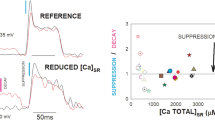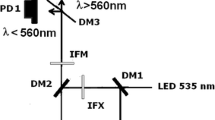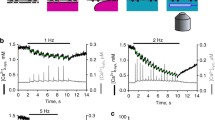Abstract
Ca2+ channels are regulated in a variety of different ways, one of which is modulation by the Ca2+ ion itself. In skeletal muscle, Ca2+ release sites are presumably located in the vicinity of the dihydropyridine-sensitive Ca2+ channel. In this study, we have tried to investigate the effects of Ca2+ release from the sarcoplasmic reticulum on the L-type Ca2+ channel in frog skeletal muscle, using the double Vaseline gap technique. We found an increase in Ca2+ current amplitude on application of caffeine, a well-known potentiator of Ca2+ release. Addition of the fast Ca2+ buffer BAPTA to the intracellular solution led to a gradual decline in Ca2+ current amplitude and eventually caused complete inhibition. Similar observations were made when the muscle fibre was perfused internally with the Ca2+ release channel blocker ruthenium red. The time course of Ca2+ current decline followed closely the increase in ruthenium red concentration. This suggests that Ca2+ release from the sarcoplasmic reticulum is involved in the regulation of L-type Ca2+ channels in frog skeletal muscle.
Similar content being viewed by others
References
Almers W, Fink R, Palade PT (1981) Calcium depletion in frog muscle tubules: the decline of Ca current under maintained depolarization. J Physiol (Lond) 312: 177–207
Armstrong D, Erxleben C, Kalman D, Lai Y, Nairn A, Greengard P (1988) Intracellular calcium controls the activity of dihydropyridine-sensitive Ca channels through protein phosphorylation and its removal. J Gen Physiol 92: 10a
Arreola J, Calvo J, García MC, Sánchez JA (1987) Modulation of calcium channels of twitch skeletal muscle fibres by adrenaline and cyclic adenosine phosphate. J Physiol (Lond) 393: 307–330
Avila-Sakar AJ, García J, Stefani E (1990) Isolation of fast Ca2+ current of frog skeletal muscle. Biophys J 57: 517a
Baylor SM, Chandler WK, Marshall MW (1983) Sarcoplasmic reticulum Ca release in frog skeletal muscle fibres estimated from arsenazo III calcium transients. J Physiol (Lond) 344: 625–666
Baylor SM, Hollingworth S, Marshall MW (1989) Effects of intracellular ruthenium red on excitation contraction coupling in intact frog skeletal muscle fibres. J Physiol (Lond) 408: 617–635
Butcher RW, Sutherland EW (1963) Adenosine 3′,5′-phosphate in biological materials. J Biol Chem 237: 1244–1250
Chang CF, Gutierrez LM, Mundiña-Weilenmann C, Hosey MM (1991) Dihydropyridine-sensitive calcium channels from skeletal muscle. 2. Functional effects of differential phosphorylation of channel subunits. J Biol Chem 266: 16 395–16 400
Chu A, Smbilla C, Inesi G, Jay SD, Campbell KP (1990) Specific association of calmodulin-dependent kinase and related substrates with the junctional sarcoplasmic reticulum. Biochemistry 29: 5899–5905
Cota G, Stefani E (1986) A fast-activated inward calcium current in twitch muscle fibres of the frog (Rana montezume). J Physiol (Lond) 370: 151–163
Csernoch L, Pizarro G, Uribe I, Rodríguez M, Ríos E (1991) Interfering with calcium release suppresses the “hump” component of intramembraneous charge movement in skeletal muscle. J Gen Physiol 97: 845–884
Delay M, Ribalet B, Vergara J (1986) Caffeine potentiation of calcium release in frog skeletal muscle fibres. J Physiol (Lond) 375: 535–559
Fedida D, Noble D, Spindler AJ (1988) Mechanisms of the use-dependent of Ca2+ current in guinea-pig ventricular myocytes. J Physiol (Lond) 405: 461–475
Feldmeyer D, Melzer W, Pohl B (1990) Effects of the Ca antagonist gallopamil (D600) upon excitation-contraction coupling in frog skeletal muscle fibres. J Physiol (Lond) 421: 521–541
Feldmeyer D, Melzer W, Pohl B, Zöllner P (1990) Fast gating kinetics of the slow Ca2+ current in cut skeletal muscle fibres of the frog. J Physiol (Lond) 425: 347–367
Feldmeyer D, Melzer W, Pohl B, Zöllner P (1991) A possible role of Ca release from the sarcoplasmic reticulum in modulating the slow Ca current in frog skeletal muscle. J Physiol (Lond) 438: 190P
Feldmeyer D, Melzer W, Pohl B, Zöllner P (1992) Modulation of calcium current gating in frog skeletal muscle by conditioning depolarization. J Physiol (Lond) 457: 639–654
Francini F, Stefani E (1989) Decay of the slow Ca current in twitch muscle fibers of the frog is influenced by intracellular EGTA. J Gen Physiol 94: 953–969
Gonzáles A, Shirokova N, Ríos E (1993) Charge movement at positive membrane potentials in skeletal muscle. Biophys J 64: A240
Gurney AM, Charnel P, Pye JM, Nargeot J (1989) Augmentation of cardiac calcium current by flash photolysis of intracellular caged-Ca2+ molecules. Nature 341: 65–68
Henček M, Zacharova D, Zachar J (1988) Fast calcium currents in cut skeletal muscle fibres of the frogs Rana temporaria and Xenopus laevis. Gen Physiol Biophys 7: 651–656
Jacquemond V, Csernoch L, Klein MG, Schneider MF (1991) Voltage-gated and calcium-gated calcium release during depolarization of skeletal muscle fibres. Biophys J 60: 867–873
Jahn H, Nastainczyk W, Röhrkasten A, Schneider T (1988) Site-specific phosphorylation of the purified receptor for calcium-channel blockers by cAMP- and cGMP-dependent protein kinases, protein kinase C, calmodulin-dependent protein kinase II and casein kinase II. Eur J Biochem 178: 535–542
Kass RS, Sanguinetti MC (1984) Inactivation of calcium channel current in the calf cardiac Purkinje fiber. J Gen Physiol 84: 705–726
Kovács L, Szűcs G (1983) Effect of caffeine on intramembrane charge movement and calcium transients in cut skeletal muscle fibres. J Physiol (Lond) 341: 559–578
Kovács L, Ríos E, Schneider MF (1983) Measurement and modification of free calcium transients in frog skeletal muscle fibres by a metallochromic indicator dye. J Physiol (Lond) 343: 161–196
Lamb GD (1992) DHP receptors and excitation-contraction coupling. J Muscle Res Cell Motil 13: 394–405
Lipp P, Mechmann S, Pott L (1987) Effects of calcium release from sarcoplasmic reticulum on membrane currents in guinea pig atrial cardioballs. Pflügers Arch 410: 121–131
Lipscombe D, Madison DV, Poenie M, Reuter H, Tsien RW, Tsien RY (1988) Imaging of cytosolic Ca2+ transients arising from Ca2+ stores and Ca2+ channels in sympathetic neurons. Neuron 1: 355–365
Luft JH (1971) Ruthenium red and violet. I. Chemistry, purification, methods of use for electron microscopy and mechanism of action. Anat Rec 171: 347–368
Ma J, Mundiña-Weilenmann C, Hosey MM, Ríos E (1991) Dihydropyridine-sensitive skeletal muscle Ca channels in polarized planar bilayers. 1. Kinetics and voltage dependence of gating. Biophys J 60: 890–901
Ma J, Gutiérrez LM, Hosey MM, Ríos E (1992) Dihydropyridine-sensitive skeletal muscle Ca channels in polarized planar bilayers. 3. Effects of phosphorylation by protein kinase C. Biophys J 63: 639–647
Marban E, Tsien RW (1982) Enhancement of calcium current during digitalis inotropy in mammalian heart: positive feedback regulation by intracellular calcium? J Physiol (Lond) 329: 589–614
McCarron JG, McGeown JG, Reardon S, Ikebe M, Fay FS, Walsh JV (1992) Calcium-dependent enhancement of calcium current in smooth muscle by calmodulin-dependent protein kinase II. Nature 357: 74–77
Melzer W, Ríos E, Schneider MF (1987) A general procedure for determining the rate of calcium release from the sarcoplasmic reticulum in skeletal muscle fibres. Biophys J 51: 849–863
Mundiña-Weilenmann C, Ma J, Ríos E, Hosey MM (1991) Dihydropyridine-sensitive skeletal muscle Ca channels in polarized planar bilayers. 2. Effects of phosphorylation by cAMP-dependent protein kinase. Biophys J 60: 902–909
Nishizuka Y (1988) The molecular heterogeneity of protein kinase C and its implications for cellular regulation. Nature 334: 661–665
Pelzer D, Pelzer S, MacDonald TF (1990) Properties and regulation of calcium channels in muscle cells. Rev Physiol Biochem Pharmacol 114: 107–207
Pizarro G, Csernoch L, Uribe I, Rodríguez M, Ríos E (1991) The relationship between Qy and Ca release from the sarcoplasmic reticulum in skeletal muscle. J Gen Physiol 97: 913–947
Ríos E, Pizarro G (1991) Voltage sensor of excitation-contraction coupling in skeletal muscle. Physiol Rev 71: 849–908
Ríos E, Brum G, Pizarro G, Rodríguez M (1990) Effects of intracellular Ca buffers on Ca transients in skeletal muscle. Biophys J 57: 341a
Rousseau E, Smith JS, Meissner G (1987) Ryanodine modifies conductance and gating behavior of single Ca2+ release channel. Am J Physiol 253: C364-C368
Sanchez JA, Stefani E (1978) Kinetic properties of calcium channels of twitch muscle fibres of the frog. J Physiol (Lond) 283: 197–209
Simon BJ, Klein MG, Schneider MF (1989) Caffeine slows turn-off of calcium release in voltage-clamped skeletal muscle fibres. Biophys J 55: 793–797
Tsien RW, Ellinor PT, Horne WA (1991) Molecular diversity of voltage-dependent Ca2+ channels. Trends Pharmacol Sci 12: 349–354
Tsien RY (1980) New calcium indicators and buffers with high selectivity against magnesium and protons: designs, synthesis, and properties of prototype structures. Biochemistry 19: 2396–2404
Zholos AV, Baidan LV, Shuba MF (1991) The inhibitory action of caffeine on calcium currents in isolated intestinal smooth muscle cells. Pflügers Arch 419: 267–273
Author information
Authors and Affiliations
Rights and permissions
About this article
Cite this article
Feldmeyer, D., Melzer, W., Pohl, B. et al. A possible role of sarcoplasmic Ca2+ release in modulating the slow Ca2+ current of skeletal muscle. Pflugers Arch. 425, 54–61 (1993). https://doi.org/10.1007/BF00374503
Received:
Revised:
Accepted:
Issue Date:
DOI: https://doi.org/10.1007/BF00374503




